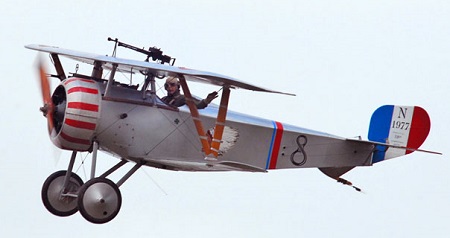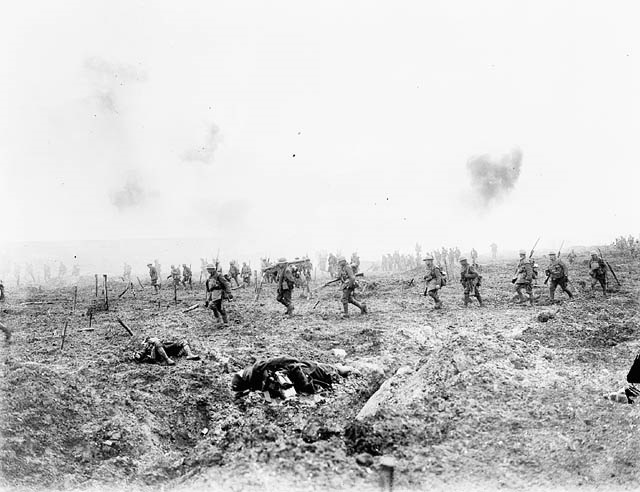About one hundred years ago, millions were involved in war – a war later to be known as the War to End All Wars. It was a global conflict of brutality, propaganda and technological advance — a war of survival and humanity and courage.
Trench warfare forced soldiers to adapt to new technology and new techniques in order to survive – something my grandsons and I learned on a recent visit to the Canadian War Museum.
The helmet, the respirator and the Lee Enfield rifle were all introduced in 1916. The helmet was in response to shrapnel artillery shells. The respirator provided some defense against chlorine and phosgene gas. The Lee-Enfield bolt-action, magazine-fed, repeating rifle replaced the unsuitable and much hated Ross Rifle.
One hundred years ago, thousands of miles of trenches crisscrossed the western front. Between the opposing trench systems lay No Man’s Land — a battered killing zone across which soldiers had to move in order to attack.
Howitzers were used to pound trenches and targets at the enemy’s rear. The eight-inch Howitzer could fire an enormous high-explosive, 200-pound shell up to seven miles. The trajectory of fire was very high, with the shell plunging downward to deliver a devastating explosion.

Shrapnel shells were designed to burst in the air, producing a cone–shaped whirl of deadly metal. Soldiers suffered horrific wounds as pieces of shrapnel ricocheted inside the body, causing further internal damage and gaping exit wounds.
The Creeping Barrage was a key to victory on the Western front. This moving wall of artillery fire forced the enemy to remain under cover, unable to fire on the attacking infantry as they moved across No Man’s Land.
Control of the air was essential for victory on the ground. Canadians played a key role in the British air services as fighter and reconnaissance pilots, aerial observers, mechanics and flight instructors. The Nieuport 17, introduced in 1916, featured a powerful engine and a synchronized Vickers machine gun. It became one of the best allied fighter planes of the war.
Improvements in combat surgery and new techniques like blood transfusions meant almost 90 per cent of all wounded soldiers who received medical treatment survived.
Doctors learned to treat the terrible wounds of modern warfare, and served in the front lines or within range of enemy artillery. Causalities were so heavy that more than half of all Canadian physicians served overseas to meet the demand.
Canadian nurses were trained medical professionals, but nothing could have prepared them for the horror of battlefield wounds — more than 3,000 served in the Canadian Army medical corps. Their wartime service assisted women to receive greater recognition within the medical profession.
To pay for the enormous cost to equip our personnel overseas, the federal government imposed a business profits tax in 1916, and an income tax for individuals in 1917. Proposed as a temporary emergency measure, the income tax became permanent.
And, almost every city and town across Ontario and the country launched campaigns to raise money. Women worked without pay to provide countless supplies and gifts, including warm clothing, bandages and food.
To quote a popular phrase of the time, everyone was encouraged to, “Do your bit,” in support of soldiers and winning the war.
A century has passed, and we remember the tremendous impact of the War to End All Wars. For the Silo, Haldimand-Norfolk MPP Toby Barrett.

Deadliest air fighter who ever lived farmed in my constituency- Norfolk
William George “Billy” Barker is the most decorated serviceman in the history of
Canada and the British Empire. Barker is one of our country’s most renowned First
World War flying aces and interestingly, has roots in Norfolk County – in the
village of Lynedoch. A fascinating fact my Executive Assistant Bobbi Ann Brady
stumbled upon.
To learn more about this hero, I visited Mount Pleasant Cemetery while working at
Queen’s Park. A plaque on his tomb was officially unveiled September 2011, and
describes Barker as “The most decorated war hero in the history of Canada, the
British Empire and the Commonwealth of Nations.”
Much the same is stated in Ottawa’s Canadian War Museum: “Lieutenant Colonel William
G. Barker, one of the legendary aces of the war, remains the most decorated Canadian
in military service.”
After enlisting at age 20 in 1914, Barker returned to Canada in May 1919 with the
Victoria Cross, the Distinguished Service Order and Bar, the Military Cross and two
Bars, two Italian Silver Medals for Military Velour, and the French Croix de guerre.
Barker’s feats are legendary. He could hit anything that moved and had an easy-going
but reckless spirit. Historians note the deadlier the war got the better Barker
became. During his service, Barker downed 50 enemy aircraft, and in his last 12
months of combat, not one pilot under his command was lost. On October 27, 1918,
Barker was wounded three times but managed to shoot down three enemy aircraft before
crash landing.
No other Canadian warrior has surpassed Barker’s record. While the name Billy Bishop
remains synonymous with WWI, Barker’s accomplishments are often forgotten. While
they did not serve together, Bishop described Barker as “the deadliest air fighter
who ever lived,” and the two were good friends. Bishop kept Barker’s story alive in
every speech, news article and book often referencing the frontier childhood he had
growing up in Manitoba where he spent his days riding horses and hunting birds.
Barker’s exploits earned him celebrity status upon his return home. Bishop and
Barker formed various companies and co-founded Canada’s first commercial airline.
The pair also launched the Canadian International Air Show at Canadian National
Exhibition (CNE). In 1927, Conn Smythe, also a flyer in WWI, named Barker the first
President of the newly-christened Toronto Maple Leafs hockey team.
Barker also married Bishop’s cousin Jean Kilbourn Smith. In 1924, the couple
arrived at Lynedoch, Haldimand-Norfolk, to grow tobacco. Although I don’t know the
location of the farm, if anyone reading knows, please advise. Respond to this post or contact me via email.
Sadly, Barker suffered permanent physical damage in his legs and left arm from the
war, and in the last few years before his tragic death, he struggled with
alcoholism. Barker died in 1930, at the age of 35, when he lost control of his
biplane trainer during a flight demonstration for the Royal Canadian Air Force
(RCAF), near Ottawa.
Barker’s state funeral was the largest in Toronto history with 50,000 attending,
including political and military leaders and an honour guard of 2,000.
As time marches on, it’s important we continue to share stories of our Canadian war
heroes. Their overseas service was just part of the sacrifice they made for you and
me, as when they returned home they were forever changed – a personal haunting we
will never know.
Toby Barrett MPP for Haldimand-Norfolk
Deadliest air fighter who ever lived farmed in my constituency -Norfolk
William George “Billy” Barker is the most decorated serviceman in the history of
Canada and the British Empire. Barker is one of our country’s most renowned First
World War flying aces and interestingly, has roots in Norfolk County – in the
village of Lynedoch. A fascinating fact my Executive Assistant Bobbi Ann Brady
stumbled upon.
To learn more about this hero, I visited Mount Pleasant Cemetery while working at
Queen’s Park. A plaque on his tomb was officially unveiled September 2011, and
describes Barker as “The most decorated war hero in the history of Canada, the
British Empire and the Commonwealth of Nations.”
Much the same is stated in Ottawa’s Canadian War Museum: “Lieutenant Colonel William
G. Barker, one of the legendary aces of the war, remains the most decorated Canadian
in military service.”
After enlisting at age 20 in 1914, Barker returned to Canada in May 1919 with the
Victoria Cross, the Distinguished Service Order and Bar, the Military Cross and two
Bars, two Italian Silver Medals for Military Velour, and the French Croix de guerre.
Barker’s feats are legendary. He could hit anything that moved and had an easy-going
but reckless spirit. Historians note the deadlier the war got the better Barker
became. During his service, Barker downed 50 enemy aircraft, and in his last 12
months of combat, not one pilot under his command was lost. On October 27, 1918,
Barker was wounded three times but managed to shoot down three enemy aircraft before
crash landing.
No other Canadian warrior has surpassed Barker’s record. While the name Billy Bishop
remains synonymous with WWI, Barker’s accomplishments are often forgotten. While
they did not serve together, Bishop described Barker as “the deadliest air fighter
who ever lived,” and the two were good friends. Bishop kept Barker’s story alive in
every speech, news article and book often referencing the frontier childhood he had
growing up in Manitoba where he spent his days riding horses and hunting birds.
Barker’s exploits earned him celebrity status upon his return home. Bishop and
Barker formed various companies and co-founded Canada’s first commercial airline.
The pair also launched the Canadian International Air Show at Canadian National
Exhibition (CNE). In 1927, Conn Smythe, also a flyer in WWI, named Barker the first
President of the newly-christened Toronto Maple Leafs hockey team.
Barker also married Bishop’s cousin Jean Kilbourn Smith. In 1924, the couple
arrived at Lynedoch, Haldimand-Norfolk, to grow tobacco. Although I don’t know the
location of the farm, if anyone reading knows, please advise.
Sadly, Barker suffered permanent physical damage in his legs and left arm from the
war, and in the last few years before his tragic death, he struggled with
alcoholism. Barker died in 1930, at the age of 35, when he lost control of his
biplane trainer during a flight demonstration for the Royal Canadian Air Force
(RCAF), near Ottawa.
Barker’s state funeral was the largest in Toronto history with 50,000 attending,
including political and military leaders and an honour guard of 2,000.
As time marches on, it’s important we continue to share stories of our Canadian war
heroes. Their overseas service was just part of the sacrifice they made for you and
me, as when they returned home they were forever changed – a personal haunting we
will never know.
Toby Barrett MPP for Haldimand-Norfolk